By John Grace
Contributing Columnist
No animal shudders the human consciousness like a bear. On their hind legs, bears can tower more than 10 feet, with jaws so powerful they can snap bones like a sprig and smash skulls.
A bear market rally describes what is often a temporary up trend in stock prices during a broader bear market. The increase is typically between 10% and 20%, which starts suddenly but does not last long.
“Notably, the Dow Jones experienced a three-month bear market rally following the stock market crash of 1929, although the bear market continued to decline until bottoming out in 1932,” according to Investopeda.com. Media outlets are fond of using the buzzword rally to describe a period of increasing prices of stocks, indexes or bonds.
A sucker rally may also be called a dead cat bounce, where there is a short-lived upward trend in prices during a longer-term bear. Despite the latest market bounce, Mike Wilson, chief U.S. equity strategist and chief investment officer at Morgan Stanley told CNBC March 4, he was preparing for an S&P 500 decline of at least 13% between now and September.
“We are doubling down on defensives because a correction is imminent,” he said.
The stock market revealed a lot of red on the screen almost immediately following incoming Vice Chair Lael Brainard who signaled in early April that the Fed may well start quantitative tightening in May instead of June.
Inflation is “transitory” no longer, where it remains at multi-decade highs and isn’t showing any definitive signs of peaking.
As the Russia-Ukraine war rages on, there were more sanctions imposed by the European Union on April 6.
While no one can see the future, it’s not necessary to try and predict what will happen by a certain date. Instead of trying to predict the future, this observer believes it is far better to prepare for the good, the bad and the unforeseen to potentially keep investor assets from being smashed.
Dent Research suggests that we keep our eye on the S&P 500 ball. Starting in January, well before Russia began crashing into Ukraine, the firm forecast that the S&P 500 could fall to around 2,560, which is 64% below the recent 4,819 top. There could be a dead cat bounce which will be a false hope to investors, but a larger decline baked into the cake putting the S&P 500 down 86%. Only time will tell if this first crash starts in April with the markets reaching the bottom around July.
Based on what I have seen, in 2008 many investors owned portfolios that remained fully invested. Some investors elected to move their money into actively managed accounts. That means instead of a 5% cash-95% invested ratio, actively managed accounts moved money from risk assets to money market accounts, and some finished the year with 50% to 100% cash so that the decline wasn’t so severe.
Had you found yourself and your loved ones on the Titanic, you didn’t live by moving the deck chairs from one location to the other. You wanted to move the deck chairs to the sandy beach, where you and your loved ones could watch the ship sink.
By analogy, when the grits hit the fan, you may prefer to have your funds moved from risk assets to safety or cash in 2008, and back fully invested starting in March 2009. Most Americans fail to learn from history because we are too busy repeating it.
John Grace is a registered representative with LPL Financial. His On the Money column runs monthly in The Wave. The opinions voiced in this material are for general information only and are not intended to provide specific advice or recommendations for any individual.











